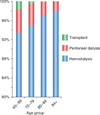Optimizing renal replacement therapy in older adults: a framework for making individualized decisions
- PMID: 22089945
- PMCID: PMC3396777
- DOI: 10.1038/ki.2011.384
Optimizing renal replacement therapy in older adults: a framework for making individualized decisions
Abstract
It is often difficult to synthesize information about the risks and benefits of recommended management strategies in older patients with end-stage renal disease since they may have more comorbidity and lower life expectancy than patients described in clinical trials or practice guidelines. In this review, we outline a framework for individualizing end-stage renal disease management decisions in older patients. The framework considers three factors: life expectancy, the risks and benefits of competing treatment strategies, and patient preferences. We illustrate the use of this framework by applying it to three key end-stage renal disease decisions in older patients with varying life expectancy: choice of dialysis modality, choice of vascular access for hemodialysis, and referral for kidney transplantation. In several instances, this approach might provide support for treatment decisions that directly contradict available practice guidelines, illustrating circumstances when strict application of guidelines may be inappropriate for certain patients. By combining quantitative estimates of benefits and harms with qualitative assessments of patient preferences, clinicians may be better able to tailor treatment recommendations to individual older patients, thereby improving the overall quality of end-stage renal disease care.
Figures



Comment in
-
Renal replacement in older adults: one size does not fit all!Kidney Int. 2012 Dec;82(12):1340-1. doi: 10.1038/ki.2012.341. Kidney Int. 2012. PMID: 23203026 No abstract available.
References
-
- Kurella M, Covinsky KE, Collins AJ, et al. Octogenarians and nonagenarians starting dialysis in the United States. Ann Intern Med. 2007;146:177–183. - PubMed
-
- Boyd CM, Darer J, Boult C, et al. Clinical practice guidelines and quality of care for older patients with multiple comorbid diseases: implications for pay for performance. JAMA. 2005;294:716–724. - PubMed
-
- Walter LC, Covinsky KE. Cancer screening in elderly patients: a framework for individualized decision making. JAMA. 2001;285:2750–2756. - PubMed
-
- Bogardus ST, Jr, Holmboe E, Jekel JF. Perils, pitfalls, and possibilities in talking about medical risk. JAMA. 1999;281:1037–1041. - PubMed
Publication types
MeSH terms
Grants and funding
LinkOut - more resources
Full Text Sources

